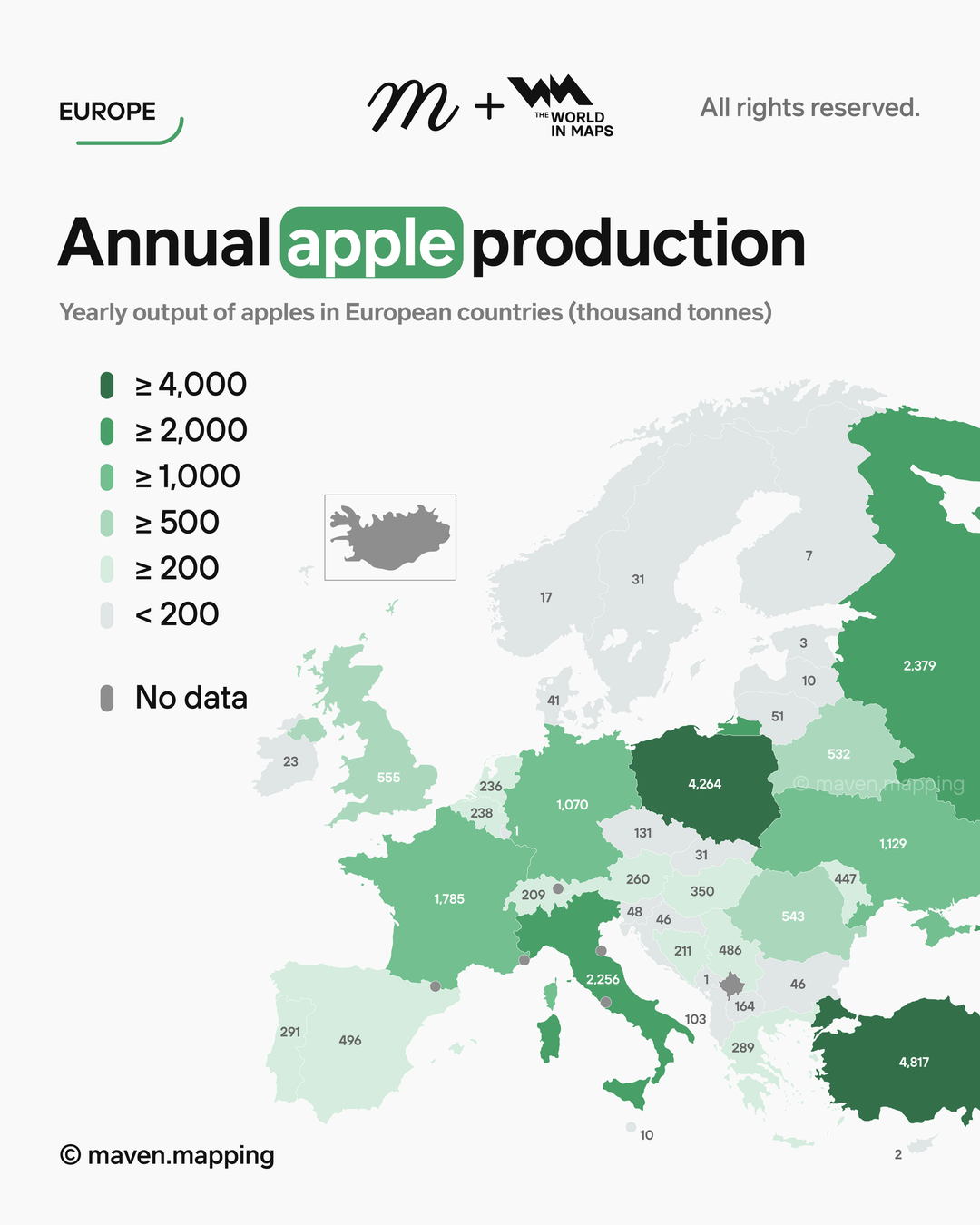Annual Apple Production in Europe Map


David Chen
Data Visualization Specialist
David Chen is an expert in transforming complex geographic datasets into compelling visual narratives. He combines his background in computer science ...
Geographic Analysis
What This Map Shows\nThis map provides a comprehensive overview of apple production across Europe, detailing the quantity of apples harvested in various countries annually. It highlights not only the leading producers but also the regions within countries that excel in apple cultivation. Understanding this data is crucial for grasping the agricultural landscape of Europe, especially when considering the economic and environmental factors tied to fruit farming.
Deep Dive into Apple Production in Europe\nApple production is a vital component of Europe's agricultural sector, with the continent being one of the largest producers of apples in the world. The diversity of climates across Europe allows for a wide variety of apple cultivars to thrive. From the tart Bramley apples in the UK to the crisp Golden Delicious in France, the range of apples cultivated is as varied as the regions themselves.
Interestingly, in 2022, it was reported that Europe collectively produced over 10 million metric tons of apples, with notable contributions from countries such as Poland, Germany, and France. Poland stands out as the leading apple producer, contributing approximately 28% of the continent's total production. This dominance can be attributed to the favorable climate and rich soil in regions like the Vistula Valley, which supports extensive orchards.
Germany and France follow closely, with each country producing around 20% of Europe’s apples. German apple farms are renowned for their efficiency and innovation, utilizing modern agricultural techniques to maximize yield. In contrast, France is celebrated for its quality, particularly in regions like Normandy and Brittany, where traditional farming methods are still prevalent, allowing for the cultivation of unique local varieties.
Moreover, the Mediterranean countries, including Italy and Spain, add diversity to the apple landscape. While they may not produce apples in the same volume as their northern counterparts, they contribute unique varieties adapted to warmer climates, such as the sweet and aromatic Annurca apple from Italy.
The European apple sector is also influenced by several socio-economic factors. For instance, the rise in consumer demand for organic produce has led to an increase in organic apple orchards, highlighting a shift towards sustainable farming practices. Notably, as of 2023, organic apple production in Europe has seen an annual growth rate of about 5%, driven by health-conscious consumers and a greater awareness of environmental issues.
Regional Analysis\nWhen we examine apple production through the lens of the map, it becomes clear how regional dynamics affect output. In Eastern Europe, for example, Poland’s central and southern regions are apple-producing powerhouses, with their favorable conditions fostering numerous orchards. In contrast, the western regions of Europe, particularly in the UK and Germany, focus on high-quality production, often catering to local markets with premium pricing.
Interestingly, the production levels in Southern Europe are less uniform. Countries like Italy may have a lower overall production but are home to specific niches that thrive, such as the aforementioned Annurca apple. Meanwhile, Spain's production is characterized by a mix of both commercial and traditional farming methods, demonstrating that even within regions, there are diverse practices and outputs.
Significance and Impact\nWhy does apple production matter? Beyond just being a staple fruit in diets across Europe, apples hold significant economic importance. The apple industry supports thousands of jobs, from orchard workers to those involved in processing and distribution. Furthermore, as consumer preferences shift towards healthy eating, apples represent an accessible, nutritious option that can be enjoyed fresh or incorporated into a variety of products.
However, the apple industry also faces challenges. Climate change poses a significant threat, with fluctuating temperatures affecting harvest yields and the viability of certain apple varieties. Projections indicate that by 2050, we may see shifts in where apples can be successfully cultivated, leading to potential decreases in production in traditional areas and increases in regions that were once considered unsuitable.
In conclusion, the map of annual apple production in Europe not only charts the geographical distribution of apple farming but also reflects the complex interplay of climate, economics, and consumer behavior in shaping the future of this beloved fruit. As we move forward, understanding these dynamics will be essential for both producers and consumers alike, ensuring that apple harvesting remains a fruitful endeavor for generations to come.
Visualization Details
- Published
- August 17, 2025
- Views
- 124
Comments
Loading comments...